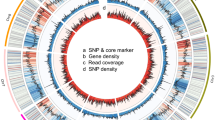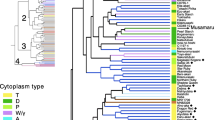Abstract
Distinctness among lucerne varieties, evaluated in DUS tests, is a frequent obstacle to variety registration. Promising varieties may fail the distinction test despite an agronomic plus-value so the genetic progress is not delivered to farmers. The Genotyping By Sequencing (GBS) technology that enables to obtain a large number of markers on pools of individuals was used to evaluate the distinction among 20 lucerne varieties of the European Catalogue. A total of 40 000 polymorphic markers was obtained. All the varieties were statistically different from the others, and the structure was consistent with knowledge on the varieties. Perspectives to use GBS in DUS testing are given.
Access provided by CONRICYT-eBooks. Download conference paper PDF
Similar content being viewed by others
Keywords
1 Introduction
Despite persistent genetic improvement of lucerne varieties, as showed by VCU tests, variety distinction is often difficult. For this reason, promising varieties may fail the distinction test and be never registered so the genetic progress is not delivered to farmers. Low throughput genotyping methods (AFLP or SSR) gave weak distinctness among lucerne varieties (Crochemore et al. 1996; Flajoulot et al. 2005). The Genotyping By Sequencing (GBS) technology that enables to obtain a large number of markers (Elshire et al. 2011) can be used on pools of individuals (Raineri et al. 2012) and has shown promising results to compare synthetic varieties of perennial ryegrass (Byrne et al. 2013) and lucerne (Annicchiarico et al. 2016). In the present UPOV regulations, molecular markers are not allowed for direct variety distinction, but they are used to structure the genetic diversity for a few species and to choose couples of varieties (applicant varieties and registered varieties) to grow side by side in the field during DUS testing (UPOV 2013). The present study was set up to evaluate the distinction among 20 lucerne varieties chosen in the European Catalogue.
2 Material and Methods
2.1 Plant Material
Twenty varieties (Table 1) obtained by different breeders have been chosen in the DUS reference catalogue to cover all the range of diversity for autumn dormancy, flower colour, disease (Colletotrichum trifolii and Verticillium alboatrum) and pest (Ditylenchus dipsaci) resistances. All varieties but one (Vernal) are registered in Europe.
2.2 Genotyping
Seeds were sown in a greenhouse and leaflets were sampled on four different bulks of 100 individuals for each variety. For each bulk, DNA extraction was carried out with a CTAB protocol. GBS librairies were built by using the restriction enzyme ApeK1 and a specific barcode for each bulk. Librairies were sequenced on an Illumina HiSeq 3000 at a the Genomic plateform GeT-PlaGe of INRA (INRA Toulouse, France) with a 150 base single-end protocol. A Linux pipeline was developed to obtain the allele frequencies. It contains the successive steps: (i) demultiplexing, (ii) trimming of the sequences; (iii) alignment of the sequences on M. truncatula reference genome sequence, version 4.0 with bwa, (iv) variant calling based on the GATK programme, (v) calculation of the allelic frequency of each SNP in each bulk obtained by the proportion of the variant allele to the total number of reads, (vi) merging of the files obtained for all bulks into a single file.
Statistical analyses were based on DAPC (Discriminant Analysis of Principal Components) with the procedure dapc of R software, calculation of FST between pairs of varieties and test for significance of FST with the procedure stamppFst of R.
3 Results and Discussion
A total of 39 424 markers was obtained. The alleles with a frequency close to 0.25 or 0.75 in the populations were the most numerous. The comparison of the 4 bulks of 100 plants showed a good correlation within each variety (Fig. 1).
With the DAPC analysis, five varieties were clearly separated from the 15 other ones (Fig. 2): 1/Juurlu is a variety from Estonia, with a dormancy of 1 and a high proportion of yellow flowers, 2/Vernal has a dormancy of 2, variegated flowers and was bred for Northern USA and Canada, 3/Greenmed is a turf variety selected from wild M. sativa populations, 4/Luzelle is a French variety adapted to grazing that contains one plant of the ssp falcata among the 13 parents of the initial polycross, and 5/Franken Neu is a German variety with a high proportion of variegated flowers. The other 15 varieties were all bred in France. When zooming on these 15 varieties, the 5 varieties adapted to the South (Midi, Meldor, Barmed, Dorine and Verdor) had the lowest values on the axis 2 than the 10 varieties adapted to the North (Artémis, Arpège, Fado, Capri, Europe, Félicia, Galaxie, Orca, Daphné, Milky Max) (Fig. 2).
The FST calculated between pairs of varieties ranged from 0.075 to 0.207 and were all highly significant (P < 0.001). This indicates that all varieties were different from the others.
On the contrary to other studies conducted with a limited number of markers (AFLP or SSR), we obtained a clear distinctness of varieties and a structure that is relevant to previous knowledge on the varieties. The high number of GBS markers obtained in the present study (close to 40 000) probably explained the better discrimination than in a study with 11 Italian landraces but only 2900 markers (Annicchiarico et al. 2016).
4 Conclusion
GBS markers, scored on bulks of individuals, proved efficient to differentiate lucerne varieties. This method could help in DUS testing. The reference collection of lucerne varieties could be genotyped with GBS markers. On this basis, taking example on the use of markers for maize distinction testing, groups of similar varieties could be established. When a new variety is submitted to registration, the first step could be to genotype it and to assign it to a group. In a second step, the phenotypic distinction tests could be carried out, within the group of similar varieties. Another strategy would be to base all distinction tests on molecular markers and to use phenotypic traits for variety description and VCU evaluation. These results can help the actors of variety registration to propose an evolution of the regulations, for better efficiency of the efforts devoted to lucerne variety distinctness.
References
Annicchiarico P, Nazzicari N, Ananta A, Carelli M, Brummer EC (2016) Assessment of cultivar distinctness in alfalfa: a comparison of genotyping-by-sequencing, simple-sequence repeat marker, and morphophysiological observations. Plant Genome 9:1–12
Byrne S, Czaban A, Studer B, Panitz F, Bendixen C, Asp T (2013) Genome wide allele frequency fingerprints (GWAFFs) of populations via genotyping by sequencing. PLoS One 8:e57438
Crochemore ML, Huyghe C, Kerlan MC, Durand F, Julier B (1996) Partitioning and distribution of RAPD variation in a set of populations of the Medicago sativa complex. Agronomie 16:421–432
Elshire RJ, Glaubitz JC, Sun Q, Poland JA, Kawamoto K, Buckler ES, Mitchell SE (2011) A robust, simple genotyping-by-sequencing (GBS) approach for high diversity species. PLoS One 6:e19379
Flajoulot S, Ronfort J, Baudouin P, Barre P, Huguet T, Huyghe C, Julier B (2005) Genetic diversity among alfalfa (Medicago sativa) cultivars coming from a single breeding program, using SSR markers. Theor Appl Genet 111:1420–1429
Raineri E, Ferretti L, Esteve-Codina A, Nevado B, Heath S, Perez-Enciso M (2012) SNP calling by sequencing pooled samples. BMC Bioinform. 13:239
UPOV (2013) Guidance of the use of biochemical and molecular markers in the examination of distinctness, uniformity and stability (DUS). http://www.upov.int/edocs/tgpdocs/en/tgp_15.pdf
Acknowledgments
This study was funded the French Ministry of Agriculture (project CASDAR Amediluze C2014-05). We thank the Genomic Plateform GeT-PlaGe of INRA in Toulouse, France, for sequencing.
Author information
Authors and Affiliations
Corresponding author
Editor information
Editors and Affiliations
Rights and permissions
Copyright information
© 2018 Springer International Publishing AG, part of Springer Nature
About this paper
Cite this paper
Julier, B. et al. (2018). Use of GBS for Lucerne Variety Distinction. In: Brazauskas, G., Statkevičiūtė, G., Jonavičienė, K. (eds) Breeding Grasses and Protein Crops in the Era of Genomics. Springer, Cham. https://doi.org/10.1007/978-3-319-89578-9_45
Download citation
DOI: https://doi.org/10.1007/978-3-319-89578-9_45
Published:
Publisher Name: Springer, Cham
Print ISBN: 978-3-319-89577-2
Online ISBN: 978-3-319-89578-9
eBook Packages: Biomedical and Life SciencesBiomedical and Life Sciences (R0)






